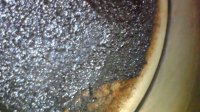All us bozos are still on this bus.
anecdotal :
I've only met one (750) that would run with 210 plus jets in it. Seems the owner felt that the float level was too high so he kept bending the tap until fuel stopped leaking from the carbs. As a consequence the fuel level was about a half inch low . Re did the float valve seats (yes it can be done) and established correct fuel level. Installed correct jets and ....
. Re did the float valve seats (yes it can be done) and established correct fuel level. Installed correct jets and ....
Then there was the infamous adjust the valves on overlap deal.
Stop tabs on the advance were allowing nearly 45 degrees advance so when set to full advance marks timing was about 5 degrees after TDC at idle.
Even though both points were opening at the same degrees before TDC their dwell was different by nearly 15 degrees.
There are only two types of stock coils. Those that have failed and those that will.
XV 750 valves that hat a bunch taken off the top?! why?!
Early crankshaft with the pressed in weights that were shifting around.
Last but not least the pistons were in backwards.
Yup all the same engine.
end anecdote
Dick brought up a good point that many miss. I keep a few old head gaskets around to check deck height vs cam degree. Tighten down on the old gasket at about 1/2 torque on the inside studs, adjust tensioner, read the wheel and dial indicator. A few thousandths of deck height does equal a few degrees either way.
~kop
anecdotal :
I've only met one (750) that would run with 210 plus jets in it. Seems the owner felt that the float level was too high so he kept bending the tap until fuel stopped leaking from the carbs. As a consequence the fuel level was about a half inch low
Then there was the infamous adjust the valves on overlap deal.
Stop tabs on the advance were allowing nearly 45 degrees advance so when set to full advance marks timing was about 5 degrees after TDC at idle.
Even though both points were opening at the same degrees before TDC their dwell was different by nearly 15 degrees.
There are only two types of stock coils. Those that have failed and those that will.
XV 750 valves that hat a bunch taken off the top?! why?!
Early crankshaft with the pressed in weights that were shifting around.
Last but not least the pistons were in backwards.
Yup all the same engine.
end anecdote
Dick brought up a good point that many miss. I keep a few old head gaskets around to check deck height vs cam degree. Tighten down on the old gasket at about 1/2 torque on the inside studs, adjust tensioner, read the wheel and dial indicator. A few thousandths of deck height does equal a few degrees either way.
~kop

